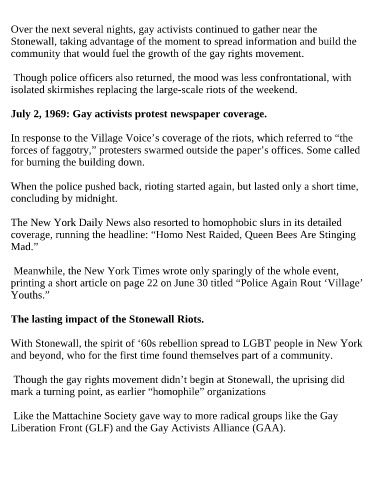Page 436 - ILIAS ATHANASIADIS AKA RO1
P. 436
Over the next several nights, gay activists continued to gather near the
Stonewall, taking advantage of the moment to spread information and build the
community that would fuel the growth of the gay rights movement.
Though police officers also returned, the mood was less confrontational, with
isolated skirmishes replacing the large-scale riots of the weekend.
July 2, 1969: Gay activists protest newspaper coverage.
In response to the Village Voice’s coverage of the riots, which referred to “the
forces of faggotry,” protesters swarmed outside the paper’s offices. Some called
for burning the building down.
When the police pushed back, rioting started again, but lasted only a short time,
concluding by midnight.
The New York Daily News also resorted to homophobic slurs in its detailed
coverage, running the headline: “Homo Nest Raided, Queen Bees Are Stinging
Mad.”
Meanwhile, the New York Times wrote only sparingly of the whole event,
printing a short article on page 22 on June 30 titled “Police Again Rout ‘Village’
Youths.”
The lasting impact of the Stonewall Riots.
With Stonewall, the spirit of ‘60s rebellion spread to LGBT people in New York
and beyond, who for the first time found themselves part of a community.
Though the gay rights movement didn’t begin at Stonewall, the uprising did
mark a turning point, as earlier “homophile” organizations
Like the Mattachine Society gave way to more radical groups like the Gay
Liberation Front (GLF) and the Gay Activists Alliance (GAA).

